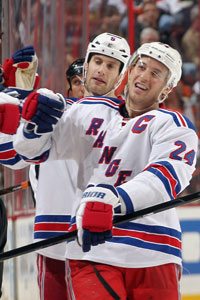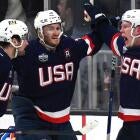John Tortorella on how to get more offense from his top forwards: 'Pray'
John Tortorella seems ready to turn to a higher power to get his top-two lines to start scoring some goals in the Eastern Conference Final.
By
Adam Gretz
•
2 min read
 During his meeting with the media on Tuesday afternoon, Rangers coach John Tortorella was asked what he can do to get his top-six forwards to start scoring more goals.
During his meeting with the media on Tuesday afternoon, Rangers coach John Tortorella was asked what he can do to get his top-six forwards to start scoring more goals. Or any goals, for that matter.
It's been a problem for the Rangers through the first four games of the Eastern Conference Final. Rookie forward Chris Kreider has scored three goals, Ryan Callahan has an empty-netter, and the rest of the top-two lines have been completely kept off the scoreboard.
So what is Tortorella going to do? Turn to a higher power, naturally.
"Pray," Tortorella said. "I don't know what else to tell you. We're going to keep on trying to play, pray, and hopefully something good happens to them."
Offense has been a constant struggle throughout the postseason for the Rangers, and they are the lowest scoring of the four teams still playing. They've narrowly avoided elimination in the opening two rounds against the bottom two seeds in the conference and have relied almost entirely on goaltender Henrik Lundqvist to bail them out. Without his play, which has been at a Conn Smythe level, it's possible, if not likely, that the Rangers would already be done playing this postseason.
While the focus is entirely on the lack of goals, the ability to score goals isn't the only issue facing the Rangers offense right now. The goals themselves are simply the end result of an entire sequence of events that take place on the ice. The Rangers have also done a poor job (and at times, a terrible job) pushing the play and simply creating chances, let alone actually putting the puck in the net.
You have to get shots and chances before you can score, and New York simply doesn't do enough of it.
A lot of that is a result of their style of play, which is very defensive (or perhaps you'd prefer to call it passive) and has them spending the majority of the time in their own end of the ice defending and blocking shots.
So far this postseason, they've attempted just 47 percent of the total shot attempts in their 21 games, a number that helps illustrate just how much time they spend defending. The only series they actually carried the play this postseason was in the second round against Washington. And that was a series against the only second-round playoff team more afraid of playing offense than the Rangers seem to be.
On an individual level, the Rangers only have five forwards this postseason that have a positive on-ice Corsi rating (total shots attempted vs. total shots allowed during 5-on-5 play): Kreider, John Mitchell, Derek Stepan, Marian Gaborik and Mike Rupp.
Tortorella made a reference to this following the Rangers Game 4 loss on Monday, saying, more than once, that his team "didn't have the puck enough."
And the numbers show it pretty clearly.
This is a big part of why the Rangers can't score. They have too many players spending too much time in their own zone playing without the puck.
All season -- and the entire postseason -- Lundqvist has been doing his part to carry the Rangers. So far, he's done it brilliantly. Now it's time for some of his teammates to help him out and give him support. And a break.
For more hockey news, rumors and analysis, follow @EyeOnHockey and @agretz on Twitter and like us on Facebook.

















